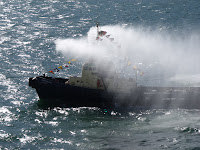 16th October 2009- Lisbon, Portugal
16th October 2009- Lisbon, Portugal....you would have seen initially the town of Caxias on our left hand side which is one of the suburbs of Lisbon, on the right hand side the white cliffs and the Cristo Rei statue similar to that found in Rio De Janeiro, some 350 feet above sea level, you would also see the Belem Tower and the monument to the Explorers on the left hand side. We transited the Rio Tejo passing under the April 25th Bridge at 11:01, so named due to a peaceful revolution which happened in 1974.



We sailed into Lisbon mid-morning and docked not far from Europe's longest suspension bridge (so they said) very reminiscent of the Golden Gate Bridge. The tour guide on the bus said it was built by the same folks. As we approached the docking area, there were boats with flags flying spraying water. Kinda cute. Found out later that they were welcoming Ruby Princess on her first visit to Lisbon. The ship went into service in 2008 and just turned one year old. I also heard that this will be the ship's first trans-Atlantic voyage. Hmmmmmm.....first voyage.....comforting thought? Actually, later someone said that the ship had crossed the Atlantic sailin in an easterly direction, so not really a first crossing.
We loaded on a bus headed for Cascais, a small, fashionable fishing village on the Bay of Cascais. We passed a number of fortifications guarding the coasline, some apparently still active military installations.

"Small"...clearly a relative term. For a person who lives outside of a community of roughly 600 people, Cascais didn't seem so small. There are mixtures of older and newer buildings, the latter lacking the charm of the former, as is usually the case.
 The streets are narrow with poorly delineated sidewalks, but some open areas sport patterned pavement made of 2 1/2- 3 inch squares.
The streets are narrow with poorly delineated sidewalks, but some open areas sport patterned pavement made of 2 1/2- 3 inch squares. Painstaking work, that.
Painstaking work, that.
Not as much statuary as in some other places.
Portugal is known for its tilework featured on the exteriors of many buildings. Both Cascais and Sintra sported fully clad buildings, as well as featured displays on exteriors. Permanent siding! One little square at a time would be daunting, but it sure seems to hold up. I wonder how it would hold up in an area with temperature extremes such as those found in oh,.....say..... northeast Oklahoma.





Road signs were tile plaques, and displays were traditional blue and white or more colorful landscapes. Some were inspired by religious belief, some civic oriented, and some just for fun.





Next, we loaded on the bus and headed for Sintra. According to our guide, the beaches were unusually busy, and some flowers were in an unseasonal bloom. The weather had been particularly warm for mid-October. We continued on up the coast, stopping for a photo op in sight of what the guide said was the westernmost point in all of continental Europe.
 The coast is very rocky, and it was easy to see that it could be very inhospitable in harsh weather. There was
The coast is very rocky, and it was easy to see that it could be very inhospitable in harsh weather. There was  very little, stunted vegetation.
very little, stunted vegetation.








